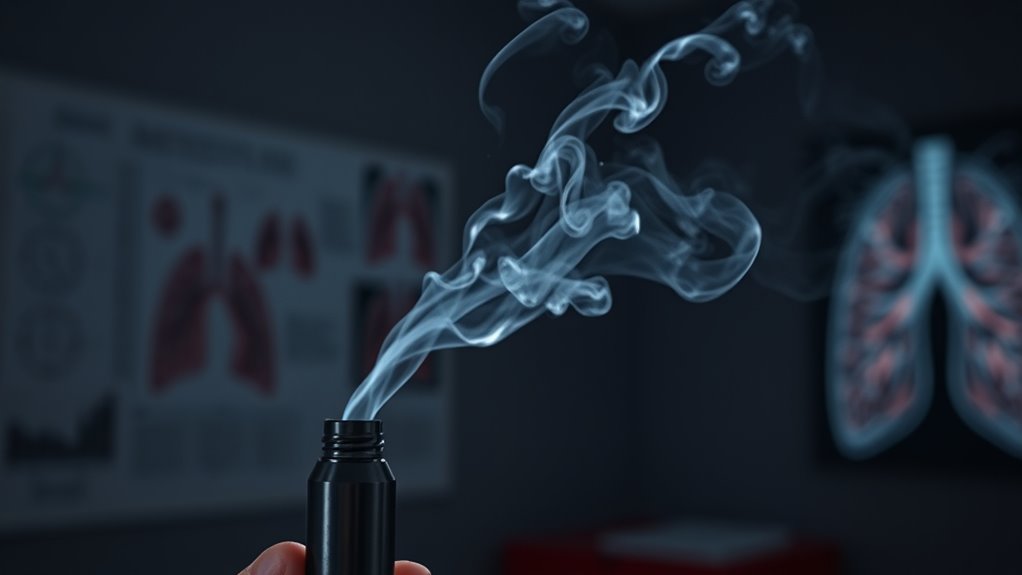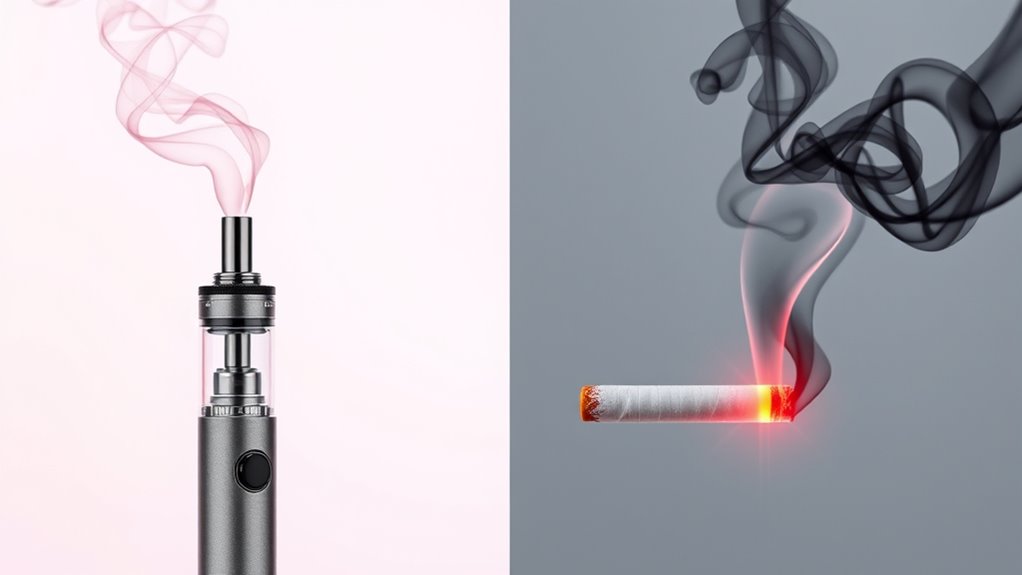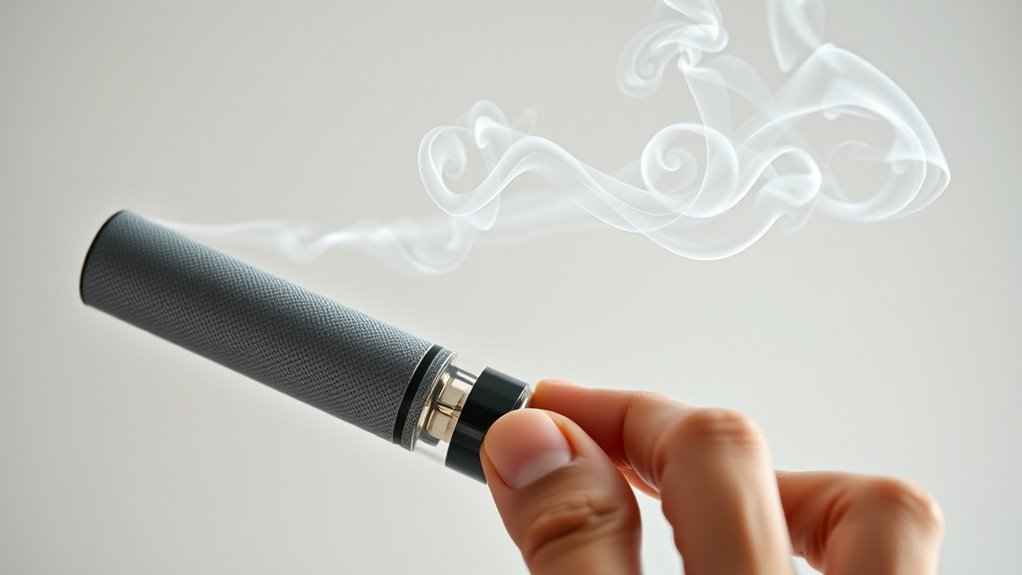In 2025, vaping remains popular, especially among young adults, but new health data shows it can severely impact your lungs. It causes inflammation, reduces lung capacity, and introduces harmful chemicals like formaldehyde and diacetyl. Devices are evolving, but risks like metal particles and thermal burns persist. While vaping might be less harmful than smoking, it still poses serious respiratory risks. Keep exploring to learn how to protect your lung health effectively.
Key Takeaways
- Vaping causes respiratory inflammation, reduced lung capacity, and increased mucus production, especially with long-term use.
- Chemical additives, including formaldehyde and diacetyl, pose significant lung health risks when heated during vaping.
- Device design and heating methods can release harmful particles and metals, exacerbating lung damage.
- 2025 data shows a decline in teenage vaping initiation, but rising use among older adults seeking smoking alternatives.
- While vaping presents fewer risks than smoking, long-term lung health impacts remain uncertain and require ongoing monitoring.
Trends in Vaping Usage and Demographics in 2025

In 2025, vaping remains a popular trend, but its usage patterns and demographics are shifting. You’ll notice more young adults, especially those aged 18-24, embracing vaping as a social activity. Meanwhile, fewer teenagers are starting to vape, partly due to increased regulations and awareness campaigns. The profile of vapers is becoming more diverse, with an uptick in older adults seeking alternatives to traditional smoking. Flavors continue to attract users, though some are now restricted in certain regions. Vaping devices are evolving, becoming more discreet and user-friendly, appealing to a broader audience. Overall, the landscape is changing from a primarily teen-focused habit to a more varied demographic, driven by evolving social norms and regulatory efforts. The development of advanced vaping technology is also contributing to these shifting trends.
Latest Findings on Vaping and Respiratory Function

Recent studies reveal that vaping can considerably impact respiratory function, often leading to inflammation and reduced lung capacity. When you vape, the inhaled aerosols irritate your airways, prompting an immune response that causes inflammation. This inflammation can damage the delicate lining of your lungs, impairing airflow and making breathing more difficult. Research from 2025 shows that even short-term vaping can decrease lung function, with some users experiencing measurable declines in lung capacity within weeks. Vaping also increases mucus production, which can clog airways and hinder oxygen exchange. These effects are particularly concerning for individuals with pre-existing respiratory conditions, as vaping exacerbates symptoms and accelerates lung deterioration. Overall, the latest findings underscore that vaping poses significant risks to your respiratory health, especially considering the impact of lifestyle choices on overall lung function.
Chemical Composition of E-Liquids and Lung Impact

The chemical makeup of e-liquids plays a crucial role in how vaping affects your lungs. Many e-liquids contain nicotine, which can cause inflammation and damage lung tissue over time. Propylene glycol and vegetable glycerin are common carriers that, when heated, can produce irritants like formaldehyde and acrolein, both linked to lung inflammation. Flavors add appeal but may contain harmful compounds, especially when heated. Some chemicals, like diacetyl, have been associated with serious lung diseases such as bronchiolitis obliterans. The specific composition of your e-liquid determines the level of risk, with certain additives and contaminants posing greater dangers. Being aware of what’s in your e-liquid helps you understand how it might impact your lung health over the long term. Additionally, research indicates that the transformative power of decluttering can help individuals better manage their health and reduce stress associated with uncertainty about product contents.
Emerging Health Concerns Related to Vaping Devices

As vaping devices become more popular, new health concerns are emerging that go beyond chemical exposure. Recent studies suggest that the design and features of these devices may pose risks you hadn’t considered. For example, some devices heat liquids unevenly, leading to the production of harmful particles or metals that can deposit in your lungs. Additionally, the frequent use of high-powered devices can cause thermal burns or injuries. There’s also concern about device malfunctions, such as battery failures, which could result in fires or explosions. These issues highlight that vaping isn’t just about what you inhale but also about the device’s safety and integrity. Staying informed about these emerging risks helps you make better choices and protect your lung health. Automation’s Role in Business Intelligence can also contribute to monitoring device safety through real-time data analysis.
Comparisons Between Vaping and Traditional Smoking Risks

While vaping is often marketed as a safer alternative to smoking, understanding the actual risks involved requires careful comparison. Traditional smoking exposes you to thousands of chemicals, many of which are carcinogenic and cause lung damage over time. Vaping, on the other hand, generally involves fewer harmful substances, but it’s not risk-free. E-cigarettes typically contain fewer toxic chemicals, reducing the likelihood of lung cancer and respiratory issues. However, vaping still delivers nicotine and potentially harmful additives that can harm lung tissue and promote addiction. Long-term effects of vaping are less understood, but current evidence suggests it’s less risky than smoking cigarettes. Still, both pose health threats, so choosing vaping over smoking doesn’t eliminate your lung health risks entirely. Protective styling benefits are also relevant when considering how to care for your lungs and overall health.
Recommendations and Preventive Measures for Vaping Users

To minimize health risks associated with vaping, it’s important to follow specific recommendations and adopt preventive measures. First, choose reputable products from trusted sources to avoid contaminants. Limit usage frequency and avoid high nicotine concentrations to reduce dependency. Regularly clean your device to prevent buildup and potential infections. Be aware of ingredients; avoid products with unknown or harmful chemicals. If you experience symptoms like coughing or shortness of breath, consult a healthcare professional immediately. Education is key—stay informed about vaping risks and updates. Here’s a quick guide:
| Recommendation | Preventive Measure |
|---|---|
| Use trusted brands | Verify product authenticity |
| Limit nicotine intake | Select lower nicotine levels |
| Regular device cleaning | Prevent bacterial buildup |
| Monitor health symptoms | Seek medical advice promptly |
| Stay informed on vaping risks | Follow reputable health sources |
Additionally, understanding the role of sound design in creating engaging educational content can enhance awareness campaigns related to health topics.
Frequently Asked Questions
How Does Secondhand Vaping Exposure Affect Lung Health?
Secondhand vaping exposes you to aerosol particles, which can harm your lung health. When you’re around others vaping, you might inhale nicotine, chemicals, and tiny toxins that can cause inflammation and reduce lung function over time. This exposure isn’t harmless; it could increase your risk of respiratory issues and exacerbate existing lung conditions. Protect yourself by avoiding enclosed spaces where people vape, especially if you have lung sensitivities.
Are There Differences in Lung Impact Between Flavored and Non-Flavored E-Liquids?
Imagine your lungs as a delicate garden, easily affected by what you introduce. Flavored e-liquids often contain chemicals that can cause more irritation and damage than non-flavored ones. You might think flavors are just a treat, but they can increase inflammation and harm lung tissue over time. So, choosing non-flavored options could be gentler, helping protect your lung garden from unnecessary harm.
What Are the Long-Term Lung Effects of Vaping Among Youth?
You should know that the long-term lung effects of vaping among youth are still being studied, but early evidence suggests risks like airway inflammation, reduced lung function, and increased susceptibility to respiratory infections. Vaping introduces chemicals that can damage lung tissue over time. As a young person, you might not feel immediate effects, but continued use could lead to serious health issues down the line. Stay informed and prioritize your lung health.
How Do Device Modifications Influence Lung Health Risks?
Think of device modifications as adding extra gears to a bike—you can go faster, but the ride becomes riskier. When you modify vaping devices, you often increase nicotine levels or alter vapor production, which can irritate your lungs and cause inflammation. These changes can also introduce harmful chemicals. So, tweaking your device might seem cool, but it considerably ups your lung health risks by exposing you to more toxins.
What Role Do Genetics Play in Vaping-Related Lung Susceptibility?
Genetics profoundly influence how your lungs respond to vaping. Your genetic makeup can determine your body’s ability to repair lung tissue, metabolize harmful chemicals, and resist inflammation. If you have certain genetic predispositions, you’re more likely to experience severe lung issues from vaping. Understanding your genetic risk factors can help you make informed choices about vaping and seek tailored medical advice to protect your lung health.
Conclusion
In 2025, over 20% of young adults vape, highlighting its growing popularity. While vaping is often seen as safer than smoking, recent studies show it can still impair lung function and expose you to harmful chemicals. Staying informed and choosing healthier habits can protect your lungs. Remember, even a small change can make a big difference—so consider your choices carefully to maintain better respiratory health moving forward.









